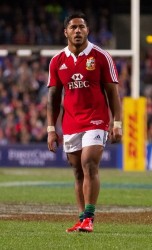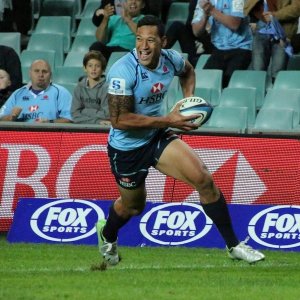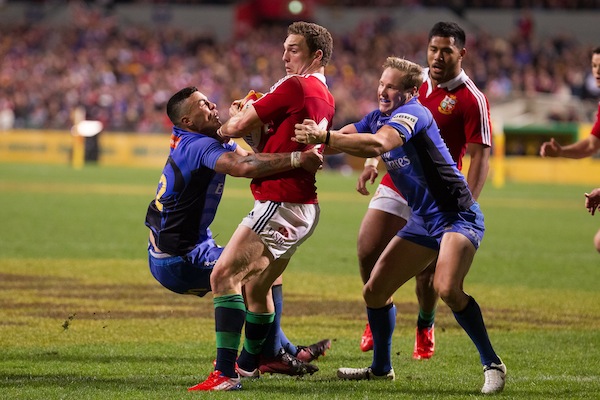Nick Bishop is an elite level video analyst and coach who has worked with the 2001 Lions, 2005 Welsh Grand Slam winners and England squads. In this series exclusive to Green and Gold Rugby, he gives a unique insight into how the Lions will view the Wallabies.
 Perhaps the single most glaring discrepancy between the two sides when you see them lining up for the national anthems in Brisbane for the all-important first Test will be the physical difference in the size of the backs.
Perhaps the single most glaring discrepancy between the two sides when you see them lining up for the national anthems in Brisbane for the all-important first Test will be the physical difference in the size of the backs.The current generation of Welsh backs contains three three-quarters who are likely to be significantly bigger than their Wallaby opposite numbers:
• Jamie Roberts 6’5 and 110kgs
• George North 6’4 and 109kgs
• Alex Cuthbert 6’6 and 108kgs
We could also throw in Roberts’ partner in the centre Jonathan Davies who is hardly a shrinking violet at 6’1 and 104kgs, while Warren Gatland will also have the option of picking England’s Manu Tuilagi, at 6’1 and 112kgs probably the most powerful back of the lot.
THE LIONS ATTACK
Scott Allen has offered a good explanation of the Wales attacking system under Gatland in his series of articles on G&G Rugby. The Lions will have a clear difference in purpose when they are whipping around the corner towards one touch-line using their forwards, or stretching the width of the field using their backs. For a start the forward phases will take about 5-6 phases to reach the far side-line, whereas the stretch phase will usually be a one-phase attack with the backs spaced to fill the entire width of the pitch.
Here is a fairly typical example from the recent Wales-Ireland Six Nations match:
http://youtu.be/uSeRdzozsd0?t=1h13m18s
From a lineout at 55:10 [game time] the Welsh forwards plus Jamie Roberts bang away for 8 phases, always moving same-way off a single pass from the base, with an occasional pick & go or in-pass [to Roberts] thrown in. When the width of the field – and hopefully the defence – has been exhausted, at 56:09 on the 9th phase the ball is moved wide back to the near side with long passes.
What is the intent behind this pattern? The basic idea is to whip around the corner quickly enough to absorb key defenders so that they cannot ‘reload’ or react fast enough to realignment by the attackers. When the ball comes back on the one-phase ‘stretch’ the theory is that there will be individual mismatches, emphasised by the wide spacing between attacking players. When the attackers are as big and powerful as George North [in this example at 56:17] the odds of a score or a line-break are considerably shorter for the offense!
The theory is not without its drawbacks. On the ‘stretch’ phase, at least two of the backs have to make long, accurate passes because of the wide spacing between attackers, and the Welsh backs have not always shown an ability to execute those passes well, as Jonathan Davies illustrates in this instance. There is also a danger of attackers becoming isolated in contact, especially if they can be cut down quickly by low tackles, see 22:45 in this clip:
http://youtu.be/Gt0RSygmX_M?t=26m5s
On the wider front, there is also the question of how Gatland would integrate the likes of Brian O’Driscoll and Tommy Bowe – fine footballers that they are – into this pattern. Neither of them are giants, and Bowe in particular may find his position in the Test team comes under threat from Alex Cuthbert for that very reason.
WHAT DOES THIS MEAN FOR DEANS’ SELECTION IN THE BACKS?
To begin with, he’ll need to have solid defence in the 10 channel from set-pieces when the Lions send Roberts or George North come down that avenue. From this point of view you can see why Deans apparently wants James O’Connor at 10 as a first-up defender, and not Quade Cooper. Whoever plays there has to have some real grit and be able to front up physically all day long.
 Edge defenders who can tackle efficiently in one-versus-one situations and get into the space between the passers to disrupt the ‘stretch’ phase will also be at a premium. Adam Ashley-Cooper can certainly do all of those things, and I suspect Nick Cummins will have a significant role to play on one wing – especially if Digby Ioane is ruled out by injury. I would have Israel Folau on the other wing. Folau is a big man physically and his rugby league experience will have taught him good technique in one-on-one tackle situations.
Edge defenders who can tackle efficiently in one-versus-one situations and get into the space between the passers to disrupt the ‘stretch’ phase will also be at a premium. Adam Ashley-Cooper can certainly do all of those things, and I suspect Nick Cummins will have a significant role to play on one wing – especially if Digby Ioane is ruled out by injury. I would have Israel Folau on the other wing. Folau is a big man physically and his rugby league experience will have taught him good technique in one-on-one tackle situations.
With Will Genia nailed on at 9, that leaves two spots open at 15 and 12. At 12 there will be a big temptation for Robbie Deans to select Pat McCabe. McCabe is a whole-hearted type who never gives less than his best and is good value at the bits and pieces around the tackle, a little like Brad Barritt for England. He is also reasonably physical, without packing as big a punch as either Roberts or Tuilagi in that department. However he is not anyone’s idea of a second distributor [very un-Australian!] and does not offer another kicking option.
I believe Australia will need that second #10 to help make use of the considerable amount of ball the Lions will kick away to them. From anywhere up to halfway, the Gatland policy is to kick long or high but nearly always infield, so kick returns may well become a prime source of possession for the Wallabies. To make maximum use of the ball they get, in my opinion Deans needs Christian Lealiifano to play 12. Lealiifano brings some physicality to the 12 spot but it is his ability to get the ball wide quickly off either hand that may well be turn out to be key to Australia’s chances.
The excellent England defence coach Andy Farrell will be working in the same role for the Lions, and his kick-chase team did show some weakness in the space between the wing and a forward defending inside him on the edge of the field in the match Australia played at Twickenham in the autumn (game time 34:25):
http://youtu.be/uWzZ5xU3-hI?t=56m14s
I suspect Kurtley Beale may well be in the mood to make a strong statement on the pitch after his recent problems, and for much the same reason as Lealiifano he should be returned to full-back, his best position for the Lions series.


